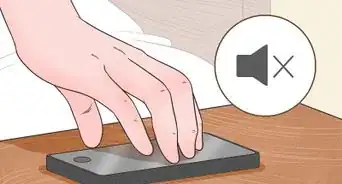This article was co-authored by Alex Dimitriu, MD. Alex Dimitriu, MD is the Owner of Menlo Park Psychiatry and Sleep Medicine, a clinic based in the San Francisco Bay Area with expertise in psychiatry, sleep, and transformational therapy. Alex earned his Doctor of Medicine from Stony Brook University in 2005 and graduated from the Stanford University School of Medicine's Sleep Medicine Residency Program in 2010. Professionally, Alex has dual board certification in psychiatry and sleep medicine.
There are 10 references cited in this article, which can be found at the bottom of the page.
wikiHow marks an article as reader-approved once it receives enough positive feedback. This article received 31 testimonials and 88% of readers who voted found it helpful, earning it our reader-approved status.
This article has been viewed 2,171,347 times.
Controlling your dreams is one of the most captivating experiences a human being can have. Have you ever wanted to re-dream your most imaginative dreams, or simply be the king or queen of your sleeping subconscious?
Steps
Recording Dreams
-
1Buy or start using a small notebook. This will be your dream journal, or a dream diary. In your dream journal, you'll write down what you hope to dream and what you remember dreaming.[1]
- Set the journal close to your bed and keep a pen nearby so that you can quickly write down what happened in the dreams you remember when you wake up. If you leave it any longer, the memory quickly fades.
- You could write your dream journal in a word processor on a computer, but it's recommended to write it in freehand. You'll spend more time putting pen to paper, making a larger connection in your brain between the dream and your recording of it.
-
2Write down what you want to dream about in your notebook. Call this your target dream. Do this every night before you go to sleep. You are imagining the environment you want to experience when you fall asleep.[2]
- Draw pictures and write down directions, using lots of detail. In fact, put in as much detail as possible; get to the point where you think you may have too much detail. Even the smallest things are important.
- The trick is to tell yourself what you are going to experience when you dream, so that you can become aware of your dreaming state while you dream.
- Don't watch television or movies before you go to bed, or you may dream about what they involved instead of your target dream.
Advertisement -
3Record your dreams. Every morning, as soon as you wake up, write down your dream. Even if you didn't have the dream you anticipated having, write it down.[3] See "Tips" below for recommendations on what to record.
- Like an athlete practicing a routine, you are training your mind to recall its dreams. The more consistently you train your mind to recall its dreams, the sharper and more heightened your dreams will become.
- Write down any parallels you remember between your target dream (the dream you wanted to have) and the dream you actually had. Be as specific as possible. Think about the similarities and differences. When interpreting the dream, keep in mind that dreams do not offer exact images or answers to your questions the way that your brain does in a waking state. Instead, the brain communicates by means of metaphors.
Practicing Wakefulness
-
1Read through your target dream. Every night, right before going to bed, go through it as many times as possible to set it fast in your head.
- After reading something one or two times, your brain thinks it knows what the words mean and gets lazy: it only processes the outline of the words and not their sense. Be sure to fully grasp the sense of your target dream so that you feel you know it inside and out before you go to sleep.
-
2Lie down, close your eyes, and think hard about your target dream. Relax. Think of specific details.[4]
- Daydream about the images from your target dream as they appear in your subconscious. Your subconscious will generate a lot of images that have nothing to do with your target dream, so cycle through the ones that are irrelevant and try to focus hard on relevant images.
- Imagine the sounds and dialogue in the background of your target dream; really try to hear them in your mind. Try to feel the sensations associated with your feeling, mood, etc.
- If no sounds or images appear clearly, try reading through your target dream again in your dream journal.
-
3Walk through your target dream. Do this in the first-person point of view, from start to finish. Imagine what it would seem like through your eyes.
- Try to walk through the target dream in the exact sequence you expect it in your dream.
- Think hard, but maintain a calm posture. Do not get tense. Just relax.
- Go to sleep with these images and sounds in your head. Remember to record your dreams, whatever they are, when you wake up.
Controlling Dreams
-
1Try "reality checks" throughout the day. A reality check is when you ask yourself: "Am I awake, or am I dreaming?" This will ultimately help you tell the difference between the dream world and reality when you are asleep.[5]
- Reality checks call attention to a fundamental difference between dreams and reality: in dreams, states are fluid; in reality, states stay the same. In dreams, text will change into different words; trees change color and shape; clocks tell time backwards instead of forwards. In reality, text stays the same, trees stay rooted in the ground, and clocks move clockwise.[6]
- A good reality check to perform, both in reality and dreams, is looking at text. Suppose a poster in your room says "Justin Bieber." Turn away for a minute, and look at the poster again. If it still says "Justin Bieber," the reality check says that you're awake. If you turn away, then look at the poster and it says "Selena Gomez," the reality check will tell you that you're dreaming.[7]
-
2Ace your reality check. When you're having a dream and realize that you are having a dream, then you start to be able to control most of what happens in your dream.
- When you make the leap and realize you're dreaming, try to calm yourself down. If you get too excited about finally being able to control your dreams, you might accidentally wake up from excitement.
- Try small activities at first. Again, this is about staying in control of your excitement and not accidentally waking up. Even mundane things like cooking food, climbing a ladder, or skateboarding can be fun when you realize you're in full control.
-
3Gradually build up to bigger activities. A lot of people enjoy flying, swimming deep into the ocean, and time travel. Try moving huge objects, passing through walls, or even telekinesis. The dreams that you can have are limited only by your imagination![8]
Warnings
- You will not immediately be able to control your dreams. It usually takes a couple trials for beginners, and may even take a couple months before you can fully control your dreams. If you're especially impatient, it may not work at all; relax!⧼thumbs_response⧽
- Be careful - some people don't fall asleep that easily after being (rudely) awakened in the middle of the night!⧼thumbs_response⧽
- Don't do anything inappropriate in your dreams: as these can start leaking into your life (believe it or not, some people think, "Well if I can do it in a dream, I can do it now!")⧼thumbs_response⧽
- If you're still and silent long enough, you may experience sleep paralysis.[10] This is normal; people sleep through it every night. Sleep paralysis may also cause WILD (Wake Induced Lucid Dreaming), but it's generally not something you should be afraid of.[11]⧼thumbs_response⧽
Things You'll Need
- Notebook
- Pencil or pen
References
- ↑ https://www.psychologytoday.com/intl/blog/dreaming-in-the-digital-age/201705/keeping-dream-journal
- ↑ https://www.howsleepworks.com/top-5-interesting-things-lucid-dreaming
- ↑ https://www.world-of-lucid-dreaming.com/dream-journal.html
- ↑ https://www.psychologytoday.com/us/blog/the-superhuman-mind/201212/lucid-dreaming-and-self-realization
- ↑ https://www.scientificamerican.com/article/how-to-control-dreams/
- ↑ https://www.world-of-lucid-dreaming.com/reality-checks.html
- ↑ https://www.world-of-lucid-dreaming.com/reality-checks.html
- ↑ https://www.medicalnewstoday.com/articles/323077.php
- ↑ http://www.dreamonapp.com/
About This Article
To control your dreams, keep a notebook next to your bed and write down what you want to dream about every night before bed. Then, read through your dream several times before going to sleep. When you close your eyes, play the dream over and over in your head. Then, when you fall asleep, you should dream about it! Once you realize that you're dreaming, you'll be able to control things in your dream and do whatever you'd like. To learn how to keep a dream journal so you're able to remember and control your dreams, keep reading!







































































